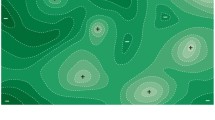Abstract
The properties of multi-peaked “fitness landscapes” have attracted attention in a wide variety of fields, including evolutionary biology. However, relaively little attention has been paid to the properties of the landscapes themselves. Herein, we suggest a framework for the mathematical treatment of such landscapes, including an explicit mathematical model. A central role in this discussion is played by the autocorrelation of fitnesses obtained from a random walk on the landscape. Our ideas about average autocorrelations allow us to formulate a condition (satisfied by a wide class of landscapes we call AR(1) landscapes) under which the average autocorrelation approximates a decaying exponential. We then show how our mathematical model can be used to estimate both the globally optimal fitnesses of AR(1) landscapes and their local structure. We illustrate some aspects of our method with computer experiments based on a single family of landscapes (Kauffman's “N-k model”), that is shown to be a generic AR(1) landscape. We close by discussing how these ideas might be useful in the “tuning” of combinatorial optimization algorithms, and in modelling in the experimental sciences.
Similar content being viewed by others
References
Binder K, Young A (1986) Spinglasses: experimental facts, theoretical concepts, and open questions. Rev Mod Phys 54:801
Brady R (1985) Optimization strategies gleaned from biological evolution. Nature 317:804
Breiman L (1968) Probability. Addison-Wesley, Reading, Mass
David H (1970) Order statistics. Wiley, New York
Eigen M, McCaskill J, Schuster P (1988) Molecular quasi-species. J Phys Chem 92:6881
Feller W (1965) An introduction to probability theory and its applications, vol 1, 3rd edn. Wiley, New York
Feller W (1972) An introduction to probability theory and its applications, vol 2, 2nd edn. Wiley, New York
Garey M, Johnson D (1979) Computers and intractability: a guide to the theory of incomputability. Freeman, San Francisco
Gumbel E (1985) Statistics of extremes. Colorado University, New York
Herstein I (1964) Topics in algebra. Blaisdell, New York
Holland J (1981) Genetic algorithms and adaptation. Technical Report # 34, University of Michigan Cognitive Sciences Department Ann Arbor, Mich
Karlin S, Taylor H (1975) A first course in stochastic processes. Academic Press, New York
Karlin S, Taylor H (1981) A second course in stochastic processes. Academic Press, New York
Kauffman S, Levin S (1987) Towards a general theory of adaptive walks on rugged landscapes. J Theor Biol 128:11–45
Kauffman S, (1989) Complex systems. In: Stein DL (eds) Proceedings of the 1988 Summer School on Complex Systems in Santa Fe, NM. Santa Fe Institute Studies in the Sciences of Complexity, Addison-Wesley, Reading, Mass
Kauffman S, Weinberger E, Perelson A (1988) Maturation of the immune response via adaptive walks on affinity landscapes. In: Perelson AS (eds) Theoretical immunology, part I. Santa Fe Institute Studies in the Sciences of Complexity. Addison-Wesley, Reading, Mass
Kirkpatrick S, Gelatt C, Vecci M (1983) Optimization by simulated annealing. Science 220:671–680
Kirkpatrick S, Toulouse G (1985) Configuration space analysis of Travelling Salesman Problems. J Phys 46:1277
Macken, C, Perelson, A (1989) Protein evolution on rugged landscapes. Proc Natl Acad Sci USA 86:6191–6195
Mandelbrot B (1982) The fractal geometry of nature. Freeman, New York
Palmer RG (1989) Complex systems. In: Stein DL (eds) Proceedings of the 1988 Summer School on Complex Systems in Santa Fe, NM. Santa Fe Institute Studies in the Sciences of Complexity. Addison-Wesley, Reading, Mass
Papoulis A (1965) Probability, random variables, and stochastic processes. McGraw-Hill, New York
Priestley M (1981) Spectral analysis and time series. Academic Press, London
Smith JM (1970) Natural selection and the concept of a protein space. Nature 225:563
Stein DL (1989) Complex systems. In: Stein DL (ed) Proceedings of the 1988 Summer School on Complex Systems in Santa Fe, NM. Santa Fe Institute Studies in the Sciences of Complexity. Addison-Wesley, Reading, Mass
Weinberger E (1987a) A stochastic generalization of Eigen's model of natural selection. PhD Thesis, Courant Institute of Mathematical Sciences, New York, NY Available from University Microfilms, Ann Arbor, Mich
Weinberger E (1987b) A model of natural selection that exhibits a dynamic phase transition. J Stat Phys 49:1011–1028
Weinberger E (1988) A more rigorous derivation of some results on rugged fitness landscapes. J Theor Biol 134:125–129
White SR (1984) Concepts of scale in simulated annealing. Proc ICCD
Wright S (1932) The roles of mutation, inbreeding, crossbreeding and selection in evolution. In: Proceedings 6th Congress on Genetics 1:356
Author information
Authors and Affiliations
Rights and permissions
About this article
Cite this article
Weinberger, E. Correlated and uncorrelated fitness landscapes and how to tell the difference. Biol. Cybern. 63, 325–336 (1990). https://doi.org/10.1007/BF00202749
Received:
Accepted:
Issue Date:
DOI: https://doi.org/10.1007/BF00202749




